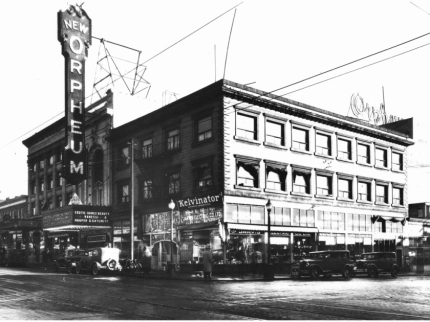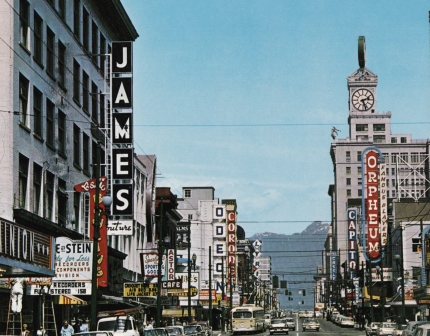

|

Orpheum Theatre - 3/13 Wurlitzer - Style 240 (original installation)
Vancouver, B.C. Canada
884 Granville St.
Organ installation timeframe: 1927 - present
Back to the B.C. Canada Original Theatre Installations page
Back to the Northwest Public Theatre Organ Installations page

Orpheum Theatre, c.1927. Photo courtesy Vancouver Public Library
The Orpheum Theatre opened on November 8, 1927 and was designed by Seattle architect B. Marcus Priteca for his patron, Alexander Pantages.
There were at least two prior Orpheum Theatres in Vancouver.
The Orpheum's Style 240 Wurlitzer, opus 1746, was shipped from the Wurlitzer factory in North Tonawanda, New York on September 28, 1927. Cost for the instrument, not including installation, was $40,000 (nearly $600k in today's dollars). The Orpheum Wurlitzer is Canada's last theatre organ still performing in its original home.
The organ has 13 ranks of pipes installed in two chambers on either side of the proscenium:
Main (left): Diaphonic Diapason, Horn Diapason, Salicional, Viol d'Orchestra, Viol Celeste,
Clarinet, Vox Humana and Concert Flute.
Solo (right): Harmonic Tuba, Brass Trumpet, Orchestral Oboe, Kinura and Tibia Clausa.

Ad for Opening Night November 8, 1927

Orpheum foyer, 1927

1929

Performers on the stage, 1946. Glimpse of Wurlitzer console in lower left. Image courtesy City of Vancouver Archives, public domain.

Performers on the stage, 1940's. Glimpse of Wurlitzer console at left. Image courtesy City of Vancouver Archives, public domain.

Unknown organist at the Orpheum, c.1940s. Image courtesy City of Vancouver Archives, public domain.

1946

1948
Two preliminary sketches for the Orpheum entrance from the workbook of B. Marcus Priteca, 1927. The final design is most similar to the sketch on the right.

Orpheum Theatre under construction, 1927. Image courtesy Vancouver Public Library, public domain.

Postcard view of Granville Street, c.1940s

Theatre District, looking North on Granville Street, early 1950s

Postcard view of Granville Street looking North from Robson, 1950s

Advertisement for Ann Leaf concert at the Orpheum, c.1978 |
Partial list of concerts:
- Korla Pandit, Fall 1968
- Don Stagg, July 1969
- Reginald Foort, November 1977
- Ann Leaf, February 1978
- George Blackmore, December 1978
- Rex Koury, April 1979
- Gaylord Carter, April 1990. Phantom of the Opera and Harold Lloyd's Billy Blazes
Servicing and tuning of the organ for the Gaylord Carter concert was done by Ted and David Quinton.
Several LP recordings of the instrument have been made including Harold Ramsay's "Wurlitzer Pipe Organ Concert" (1964) and Patrick Weld's "Strike Up the Band" (1987). The latter may have been re-released on CD. |

Orpheum interior, date unknown
In 1973, the Orpheum's owners, Famous Players, wanted to divide the theatre into a multi-screen facility. This created a public furvor, resulting in the City of Vancouver purchasing the building for $7.1 million. In 1975 the theatre was closed for repair and refurbishment, reopening on April 2, 1977. The Orpheum has been home to the Vancouver Symphony Orchestra since that time. Alterations were made to enlarge the stage to accommodate a full symphony orchestra and a new sound shell, designed to match the theatre's original ornamentation, was built to improve acoustics for the orchestra.
Anthony Heinsbergen, from a Los Angeles theatre design company, who had worked on the Orpheum Theatre in 1926, returned 50 years later to participate in the venue's restoration. Mr. Heinsbergen was most proud of his work on the ceiling dome murals which he created in his home studio in Los Angeles in 1976. The painting was done in 24 panels, teken to the theatre and applied like wallpaper. Unfortunately, Mr. Heinsbergen passed in June of 1981. In his long career, he decorated nearly 750 theatres in western part of the United States and Canada.
In other changes, a seperate Smithe Street entrance was added to the theatre in 1983.

c.2014

Stage view showing Wurlitzer console, Photo courtesy Orpheum Theatre.

Proscenium and ceiling dome, photo courtesy Orpheum Theatre.

|
Reginald Foort to play dual concert role in Vancouver
Excerpt from The Console magazine, October 1977 (v15 No 10, pp1):
Reginald Foort, one of Britain's leading theatre organists for many years, will reopen the
former Vancouver Orpheum Theatre 3m/13r Wurlitzer organ in concert November 12 and 13. The
theatre has been rennovated as a concert hall and home of the Vancouver Symphony Orchestra.
The organ was retained to be used for recitals.
The two-day event is a dual engagement for the famous artist - the reopening of the
instrument and Foort's final public appearance as a concert personality. It will be his
farewell concert.
* Planning Regular Concert Programs*
Plans are being made to use the Wurlitzer at least four times yearly. Herbert McDonald is
in charge of arrangements and will welcome inquiries from organ concert artists.
|
|

Opening Night Program, 1927

Program, 1931

c.1950s

c.1965

The following article appeared in the Vancouver Sun Wednesday, November 6, 2002 Page B7
Mighty Wurlitzer played from opening day By John Mackie
When it opened on Nov. 7, 1927, the Orpheum Theatre was a marvel of vaudeville/movie palace design. No 1927 vaudeville or movie palace was complete without the latest musical marvel to accompany the live acts and silent films: a Wurlitzer theatre organ.
Seventy-five years after the theatre opened, the Orpheum's mighty Wurlitzer remains in the orchestra pit at the foot of the stage, the only theatre organ still in its original locale in Canada. It's also the only instrument left in the Orpheum's orchestra pit, which was taken out so the stage could be expanded in 1977. Theatre organs were pipe organs modified for theatrical use; the Orpheum's Wurlitzer 240 has buttons for a whooshing "surf" sound, a bird's twitter, the honk of an auto horn and the bzzzz of a door bell. Press the correct keys and you can play a 1927 drum set hidden high above the east side of the stage.
However, the Wurlitzer's main claim to fame is its ability to simulate all sorts of instruments, including a trumpet, tuba, clarinet, oboe, celeste, flute, marimba, chimes, xylophone, glockenspiel, sleigh bells, cello, piccolo and harp. To produce such a broad array of sounds, about 1,300 pipes are hidden behind screens on either side of the stage. "It works on wind pressure," says organ aficionado Jim Tarling. "The wind is provided by a three-stage blower [fan] in the basement."
In the days of silent movies, organs were essential. "Turn the video off on your television for a bit [and watch a movie]," says theatre historian Norman Young. "It's not very interesting at all. They discovered that very early, but try as they could, they couldn't get sound on film. But they knew you had to have something, so they had music. "If you were in a little theatre in Kitsilano in 1922, when the film came, along with it comes a score for the piano [or organ]. They'd play chase music, or romantic music, or dramatic or mysterious or comic, whatever music went with what was happening on the screen so you could make emotional contact with the movie."
The Wurlitzer cost $45,000 in 1927, the year Al Jolson's talking picture The Jazz Singer revolutionized movies. Seeing the impact of the talkies, the Orpheum builders tried to cancel the order for the Wurlitzer, but it was already en route from New York with another big Wurlitzer destined for the Capitol theatre.
The organ was a big hit in the early days of the theatre; organists such as Ivy Evans at the Orpheum and Sidney Kelland at the Capitol were stars. "When the movie stopped and before the curtains opened for the vaudeville, the organ would rise out of the orchestra pit and there would be an organ interlude of a few minutes," says big band legend Dal Richards. "Then the vaudeville would begin."
Vancouver's big theatres also had orchestras: Calvin Winter and the Capitolians at the Capitol, Earl Hill and His RKOliums (after RKO entertainment) at the Orpheum. Unfortunately for the musicians, the talkies not only killed silent film, they killed vaudeville. "Calvin Winter had 21 musicians in the pit in the Capitol," says Young. "There were 20 in the Orpheum, and two organists, so 43 musicians [between the two]. The talkies come, and two or three years later all those guys were all out of work."
Most theatre organs were sold and moved to churches. "The theatres didn't want them because of the maintenance [costs]," says Tarling. "Most of the theatres were heated with coal, and they had a lot of dust [which worked into the pipes]." Tarling knows from experience, because he purchased the Capitol's Wurlitzer in 1965.
Working after the theatre closed at midnight, Tarling spent three months taking the organ apart and moving it. In 1972, he built a 1,000-square-foot addition to his house for the organ, which he plays regularly. He even has some silent movies to play along to.
The Orpheum's Wurlitzer remained in place. The most substantial change it has gone through was having its mahogany surface covered by a garish coat of cream and gold paint in the late 1970s. Sadly, the Wurlitzer is only used a handful of times per year, and even then, isn't always visible. Organist Terry Fullerton says when the Vancouver Symphony and Bach Choir join on stage, there isn't room for the organ, so he plays it from beneath the stage in the orchestra pit. He watches proceedings on a video monitor to know when to play.
There has been talk of rebuilding the Wurlitzer to make it better for symphonic use. Tarling says this would be sacrilege. Theatre organs like it now sell for about $80,000; people build backyard theatres in which to put them in. "A theatre organ is different to a church or classical organ, completely different," says Tarling. "They have a jazzier sound, and all these sound effects. You don't have a surf sound or a whistle blowing in a church."
|




























